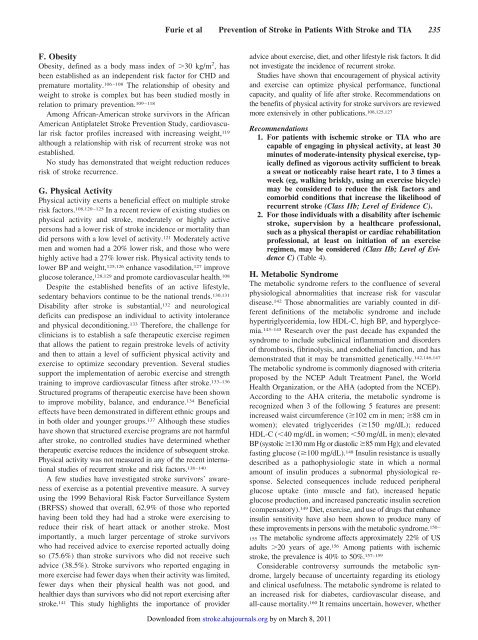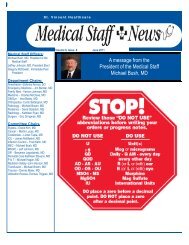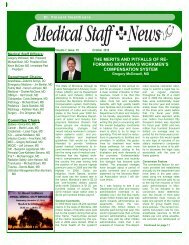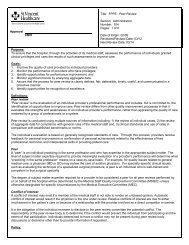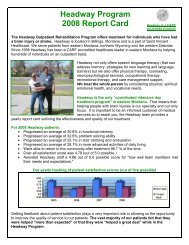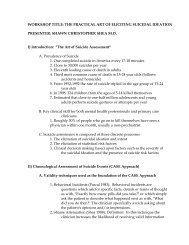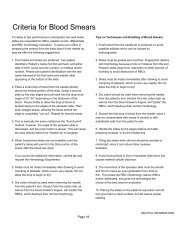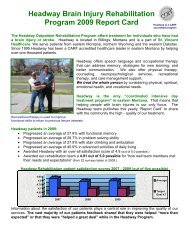AHA/ASA Guideline Guidelines for the Prevention of Stroke in ...
AHA/ASA Guideline Guidelines for the Prevention of Stroke in ...
AHA/ASA Guideline Guidelines for the Prevention of Stroke in ...
Create successful ePaper yourself
Turn your PDF publications into a flip-book with our unique Google optimized e-Paper software.
Furie et al <strong>Prevention</strong> <strong>of</strong> <strong>Stroke</strong> <strong>in</strong> Patients With <strong>Stroke</strong> and TIA 235F. ObesityObesity, def<strong>in</strong>ed as a body mass <strong>in</strong>dex <strong>of</strong> 30 kg/m 2 , hasbeen established as an <strong>in</strong>dependent risk factor <strong>for</strong> CHD andpremature mortality. 106–108 The relationship <strong>of</strong> obesity andweight to stroke is complex but has been studied mostly <strong>in</strong>relation to primary prevention. 109–118Among African-American stroke survivors <strong>in</strong> <strong>the</strong> AfricanAmerican Antiplatelet <strong>Stroke</strong> <strong>Prevention</strong> Study, cardiovascularrisk factor pr<strong>of</strong>iles <strong>in</strong>creased with <strong>in</strong>creas<strong>in</strong>g weight, 119although a relationship with risk <strong>of</strong> recurrent stroke was notestablished.No study has demonstrated that weight reduction reducesrisk <strong>of</strong> stroke recurrence.G. Physical ActivityPhysical activity exerts a beneficial effect on multiple strokerisk factors. 108,120–125 In a recent review <strong>of</strong> exist<strong>in</strong>g studies onphysical activity and stroke, moderately or highly activepersons had a lower risk <strong>of</strong> stroke <strong>in</strong>cidence or mortality thandid persons with a low level <strong>of</strong> activity. 121 Moderately activemen and women had a 20% lower risk, and those who werehighly active had a 27% lower risk. Physical activity tends tolower BP and weight, 125,126 enhance vasodilation, 127 improveglucose tolerance, 128,129 and promote cardiovascular health. 108Despite <strong>the</strong> established benefits <strong>of</strong> an active lifestyle,sedentary behaviors cont<strong>in</strong>ue to be <strong>the</strong> national trends. 130,131Disability after stroke is substantial, 132 and neurologicaldeficits can predispose an <strong>in</strong>dividual to activity <strong>in</strong>toleranceand physical decondition<strong>in</strong>g. 133 There<strong>for</strong>e, <strong>the</strong> challenge <strong>for</strong>cl<strong>in</strong>icians is to establish a safe <strong>the</strong>rapeutic exercise regimenthat allows <strong>the</strong> patient to rega<strong>in</strong> prestroke levels <strong>of</strong> activityand <strong>the</strong>n to atta<strong>in</strong> a level <strong>of</strong> sufficient physical activity andexercise to optimize secondary prevention. Several studiessupport <strong>the</strong> implementation <strong>of</strong> aerobic exercise and strengthtra<strong>in</strong><strong>in</strong>g to improve cardiovascular fitness after stroke. 133–136Structured programs <strong>of</strong> <strong>the</strong>rapeutic exercise have been shownto improve mobility, balance, and endurance. 134 Beneficialeffects have been demonstrated <strong>in</strong> different ethnic groups and<strong>in</strong> both older and younger groups. 137 Although <strong>the</strong>se studieshave shown that structured exercise programs are not harmfulafter stroke, no controlled studies have determ<strong>in</strong>ed whe<strong>the</strong>r<strong>the</strong>rapeutic exercise reduces <strong>the</strong> <strong>in</strong>cidence <strong>of</strong> subsequent stroke.Physical activity was not measured <strong>in</strong> any <strong>of</strong> <strong>the</strong> recent <strong>in</strong>ternationalstudies <strong>of</strong> recurrent stroke and risk factors. 138–140A few studies have <strong>in</strong>vestigated stroke survivors’ awareness<strong>of</strong> exercise as a potential preventive measure. A surveyus<strong>in</strong>g <strong>the</strong> 1999 Behavioral Risk Factor Surveillance System(BRFSS) showed that overall, 62.9% <strong>of</strong> those who reportedhav<strong>in</strong>g been told <strong>the</strong>y had had a stroke were exercis<strong>in</strong>g toreduce <strong>the</strong>ir risk <strong>of</strong> heart attack or ano<strong>the</strong>r stroke. Mostimportantly, a much larger percentage <strong>of</strong> stroke survivorswho had received advice to exercise reported actually do<strong>in</strong>gso (75.6%) than stroke survivors who did not receive suchadvice (38.5%). <strong>Stroke</strong> survivors who reported engag<strong>in</strong>g <strong>in</strong>more exercise had fewer days when <strong>the</strong>ir activity was limited,fewer days when <strong>the</strong>ir physical health was not good, andhealthier days than survivors who did not report exercis<strong>in</strong>g afterstroke. 141 This study highlights <strong>the</strong> importance <strong>of</strong> provideradvice about exercise, diet, and o<strong>the</strong>r lifestyle risk factors. It didnot <strong>in</strong>vestigate <strong>the</strong> <strong>in</strong>cidence <strong>of</strong> recurrent stroke.Studies have shown that encouragement <strong>of</strong> physical activityand exercise can optimize physical per<strong>for</strong>mance, functionalcapacity, and quality <strong>of</strong> life after stroke. Recommendations on<strong>the</strong> benefits <strong>of</strong> physical activity <strong>for</strong> stroke survivors are reviewedmore extensively <strong>in</strong> o<strong>the</strong>r publications. 108,125,127Recommendations1. For patients with ischemic stroke or TIA who arecapable <strong>of</strong> engag<strong>in</strong>g <strong>in</strong> physical activity, at least 30m<strong>in</strong>utes <strong>of</strong> moderate-<strong>in</strong>tensity physical exercise, typicallydef<strong>in</strong>ed as vigorous activity sufficient to breaka sweat or noticeably raise heart rate, 1 to 3 times aweek (eg, walk<strong>in</strong>g briskly, us<strong>in</strong>g an exercise bicycle)may be considered to reduce <strong>the</strong> risk factors andcomorbid conditions that <strong>in</strong>crease <strong>the</strong> likelihood <strong>of</strong>recurrent stroke (Class IIb; Level <strong>of</strong> Evidence C).2. For those <strong>in</strong>dividuals with a disability after ischemicstroke, supervision by a healthcare pr<strong>of</strong>essional,such as a physical <strong>the</strong>rapist or cardiac rehabilitationpr<strong>of</strong>essional, at least on <strong>in</strong>itiation <strong>of</strong> an exerciseregimen, may be considered (Class IIb; Level <strong>of</strong> EvidenceC) (Table 4).H. Metabolic SyndromeThe metabolic syndrome refers to <strong>the</strong> confluence <strong>of</strong> severalphysiological abnormalities that <strong>in</strong>crease risk <strong>for</strong> vasculardisease. 142 Those abnormalities are variably counted <strong>in</strong> differentdef<strong>in</strong>itions <strong>of</strong> <strong>the</strong> metabolic syndrome and <strong>in</strong>cludehypertriglyceridemia, low HDL-C, high BP, and hyperglycemia.143–145 Research over <strong>the</strong> past decade has expanded <strong>the</strong>syndrome to <strong>in</strong>clude subcl<strong>in</strong>ical <strong>in</strong>flammation and disorders<strong>of</strong> thrombosis, fibr<strong>in</strong>olysis, and endo<strong>the</strong>lial function, and hasdemonstrated that it may be transmitted genetically. 142,146,147The metabolic syndrome is commonly diagnosed with criteriaproposed by <strong>the</strong> NCEP Adult Treatment Panel, <strong>the</strong> WorldHealth Organization, or <strong>the</strong> <strong>AHA</strong> (adopted from <strong>the</strong> NCEP).Accord<strong>in</strong>g to <strong>the</strong> <strong>AHA</strong> criteria, <strong>the</strong> metabolic syndrome isrecognized when 3 <strong>of</strong> <strong>the</strong> follow<strong>in</strong>g 5 features are present:<strong>in</strong>creased waist circumference (102 cm <strong>in</strong> men; 88 cm <strong>in</strong>women); elevated triglycerides (150 mg/dL); reducedHDL-C (40 mg/dL <strong>in</strong> women; 50 mg/dL <strong>in</strong> men); elevatedBP (systolic 130 mm Hg or diastolic 85 mm Hg); and elevatedfast<strong>in</strong>g glucose (100 mg/dL). 148 Insul<strong>in</strong> resistance is usuallydescribed as a pathophysiologic state <strong>in</strong> which a normalamount <strong>of</strong> <strong>in</strong>sul<strong>in</strong> produces a subnormal physiological response.Selected consequences <strong>in</strong>clude reduced peripheralglucose uptake (<strong>in</strong>to muscle and fat), <strong>in</strong>creased hepaticglucose production, and <strong>in</strong>creased pancreatic <strong>in</strong>sul<strong>in</strong> secretion(compensatory). 149 Diet, exercise, and use <strong>of</strong> drugs that enhance<strong>in</strong>sul<strong>in</strong> sensitivity have also been shown to produce many <strong>of</strong><strong>the</strong>se improvements <strong>in</strong> persons with <strong>the</strong> metabolic syndrome. 150–155 The metabolic syndrome affects approximately 22% <strong>of</strong> USadults 20 years <strong>of</strong> age. 156 Among patients with ischemicstroke, <strong>the</strong> prevalence is 40% to 50%. 157–159Considerable controversy surrounds <strong>the</strong> metabolic syndrome,largely because <strong>of</strong> uncerta<strong>in</strong>ty regard<strong>in</strong>g its etiologyand cl<strong>in</strong>ical usefulness. The metabolic syndrome is related toan <strong>in</strong>creased risk <strong>for</strong> diabetes, cardiovascular disease, andall-cause mortality. 160 It rema<strong>in</strong>s uncerta<strong>in</strong>, however, whe<strong>the</strong>rDownloaded from stroke.ahajournals.org by on March 8, 2011


